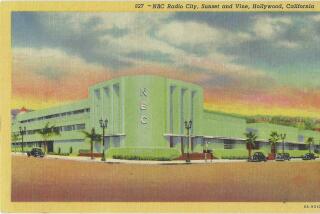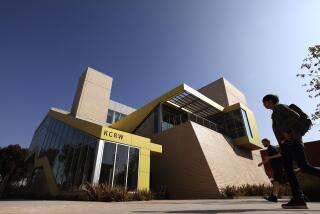For Little KCSN, Transmission Is the Mission
- Share via
At first blush, public radio station KCSN-FM (88.5) is easily dwarfed by its larger brethren of the airwaves. The eclectic station, based at Cal State Northridge, relies on power that’s little more than your typical home lightbulb: just 52 watts.
But in a case in which size does matter, KCSN is about to amp up its audience reach with a new antenna atop Oat Mountain, high above Porter Ranch in the San Fernando Valley.
On Feb. 29, when the new transmitter is flipped on, the station will be boosted to 320 watts. That means a stronger signal to its primary audience area in the San Fernando, Santa Clarita and Conejo valleys, as well as to listeners in the South Bay and mid-city, who will easily be able to find the signal because of the physics of radio waves and geography.
The 37-year-old station has a loyal following that craves its diverse audio smorgasbord, from its mainstay of classical music to Kahuna’s Green Room (surf tunes from Dick Dale, the Beach Boys) to Citybilly (folk, country, bluegrass). Its student-run news programs have won armfuls of Golden Mikes, edging out professional broadcasts. And even Deadheads tune in, since KCSN is the only L.A. radio station to air the syndicated Grateful Dead Hour.
“We’re trying to do something nobody else does,” said William Toutant, CSUN’s interim dean of the College of Arts, Media, and Communications, who also hosts KCSN’s Thursday night opera series. “It’s radio for music lovers.”
The new transmitter, a project that started 10 years ago, cost between $130,000 and $150,000, said KCSN general manager Rene Engel. The university, with significant lobbying by students, donated $60,000 and another $25,000 came from an anonymous donor. The station’s “Adopt a Watt” fund-raisers picked up the balance, Engel said.
According to Titus Levi, a USC assistant professor at the Annenberg School for Communication who studies radio and is a former deejay, the channel’s broader reach should catch the ears of more people, including those on the Westside of Los Angeles.
In that area, KCRW-FM (89.9) at Santa Monica College dominates the public radio audience with a creative mix of locally produced music shows and National Public Radio news and culture programs. It dwarfs KCSN in power, with 7,500 watts, and subscribers, with 57,000 compared to KCSN’s 2,500 members.
But Jennifer Ferro, KCRW’s assistant general manager, views the CSUN station’s entry as complementary, not competitive, even though Engel and several program hosts once worked at the Santa Monica station.
*
KCSN carries Public Radio International programs, such as “Prairie Home Companion” and “A Writer’s Almanac” with Garrison Keillor, but it is not an NPR affiliate (it does air NPR’s “Performance Today” by special arrangement).
By contrast, Ferro said KCRW is keeping a close eye on KPCC-FM (89.3), a public radio station at Pasadena City College, because of its proximity to KCRW on the dial and it is a fellow NPR channel airing much of the same programming, like “Morning Edition” and “All Things Considered.”
The stakes were increased in January when Minnesota Public Radio took over operation of KPCC with the intention of tripling its budgets and turning it into a major, in-depth local news outlet. The new managers plan to add 25 staff positions, including news, development and marketing personnel.
The tiny KCSN, currently housed in four adjoining Cal State Northridge student dorm rooms since the 1994 Northridge quake, has carved out a small station niche with its unorthodox mix of music and strong local news, Levi said. “They bring in that element of surprise,” he said.
“This is very personal radio,” added Martin Perlich, the host of an arts interview show. “The people on air here play what they like. No one has ever told us what not to play.”
Another unique feature is its student-run newscast focusing on local San Fernando Valley news.
With 43 Golden Mikes, KCSN regularly beats out professional news radio teams from Ventura, Bakersfield and Palm Springs, said Keith Goldstein, its news director and only full-time staff professional. A morning news program airs each half-hour from 6:30 to 8 a.m., and each weeknight the half-hour “Evening Update” comes on at 6.
While classical music is KCSN’s mainstay, the station isn’t so stuffy that it neglects its college radio roots.
This is, after all, the scrappy channel that returned to the airwaves 48 hours after the Northridge temblor from a tent in the middle of campus. Eventually, someone loaned them a Winnebago, and six moves later, they set up shop in their present dorm digs.
KCSN’s long tradition of a late-night, student rock music show veers so far off from its classical playlist it seems schizophrenic.
Yet “Sarcastic Fringehead,” a seven-hour alternative music block for night owls--10 p.m. Saturday to 5 a.m. Sunday, has snared its own set of dedicated fans.
“It’s on the outer skirts of alternative,” said former deejay Raphael Tulino, now an operations manager at a San Francisco station. “We played the B side.”
*
“Sarcastic Fringehead” also gave students like Tulino a chance to learn radio from the inside--how to access a music library, run programming software and deejay into the wee hours, Engel said.
For Tulino, KCSN was his first radio break. He remembered well the lean years of fund-raising for the antenna while higher-profile public radio stations with stronger signals could drum up big dollars in a flash.
“Hallelujah,” he said of the coming antenna debut. “I wish it happened when I was there.”
More to Read
The biggest entertainment stories
Get our big stories about Hollywood, film, television, music, arts, culture and more right in your inbox as soon as they publish.
You may occasionally receive promotional content from the Los Angeles Times.










